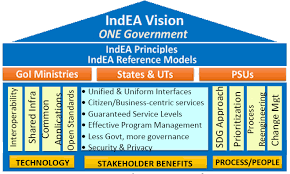Meghalaya Enterprise Architecture Project (MeghEA) | 28 Sep 2021
Why in News
Recently, Meghalaya Enterprise Architecture Project (MeghEA) was launched.
- The project aims to improve service delivery and governance for the people using the power of Digital technologies.
- Enterprise Architecture (EA) is the process by which organizations standardize and organize IT (Information Technology) infrastructure to align with business goals.
Key Points
- About:
- The initiative is spread across 6 pillars i.e. Governance, Human Resources, Entrepreneurship, Primary Sector, Infrastructure and Environment, and envision to make Meghalaya a high income state by 2030.
- The initiative is in line with the vision of Digital India that focuses on transforming India into a digitally empowered society and knowledge economy.
- With the notification of India Enterprise Architecture (IndEA) in 2018, design and implementation of integrated, nationally portable and scalable digital platforms have gained a new momentum.
- India Enterprise Architecture (IndEA):
- IndEA is a framework for developing a holistic architecture treating the Government as a single enterprise or more realistically, as an Enterprise of Enterprises, which are functionally interrelated.
- It is a structured combination of several Reference Models that, together, enable a boundary-less flow of information across the length and breadth of the government and facilitate the delivery of integrated services to the stakeholders, namely, the citizens, businesses and employees.
- IndEA framework comprises 8 Reference Models, viz., Business, Application, Data, Technology, Performance, Security, Integration and Architecture Governance.
- It is a comprehensive and convenient framework for developing Enterprise Architecture to support Information and Communication Technology (ICT) enabled transformation across governments.
- It is a way to establish Unity in Diversity in the domain of e-Governance.
- Federated Architectural Pattern is chosen for the IndEA framework for better administrative feasibility, need for decentralization of implementations, on-boarding of legacy/ ongoing efforts of e-Governance and above all, the need for state governments to have the flexibility to build state specific ICT services.
- Benefits of IndEA:
- Provide a ONE Government Experience to the citizens and businesses.
- Enhance the efficiency of delivery of services.
- Improve the effectiveness of implementation of the developmental and welfare schemes through a holistic performance management.
- Enhance the productivity of employees and agencies through easy access to information.
- Bring in flexibility and agility in making changes to the systems to align with the best practices and to leverage the latest technologies.
- Realize cost-effectiveness through use of shared infrastructure and services.
- Maintain the right balance between security of data and privacy of personal information.

